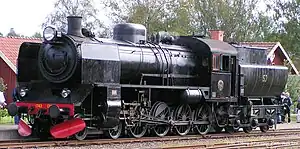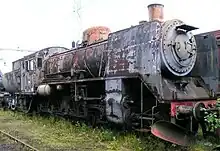SJ E10
The Swedish State Railways class E10 was a type of steam locomotive which was used for freight traffic. Ten locomotives were built in 1947 as a slightly modified version of the older E9 class. They were used mainly on the Inland Line, before being placed in the strategic reserve, where some remained until 1990; five of them have been preserved.
| SJ E10 | |||||||||||||||||||||||
|---|---|---|---|---|---|---|---|---|---|---|---|---|---|---|---|---|---|---|---|---|---|---|---|
 SJ E10 1742 at the Swedish Railway Museum in Gävle, 2006 | |||||||||||||||||||||||
| |||||||||||||||||||||||
| |||||||||||||||||||||||
| |||||||||||||||||||||||
| |||||||||||||||||||||||
| References:[1][2] | |||||||||||||||||||||||
History

In the 1940s the Swedish State Railways (SJ) saw a need for modern steam locomotives for freight traffic on the Inland Line and in southern Norrland.[3]: 93 When the private railway company Halmstad–Nässjö Järnväg (HNJ) was nationalized in 1945, their G12 class three-cylinder 4-8-0 locomotives became the E9 class of SJ.[3]: 93 Impressed[1][4] by these smooth-running locomotives with high traction and a low axle load, SJ ordered ten E10 locomotives from NOHAB, based on the E9.[1]
The E10 locomotives, delivered in 1947,[1] were the last large steam locomotives built for the Swedish railways.[5] The class differed from the E9 by having roller bearings, fully enclosed cabs, and slightly different fireboxes.[1] They were given tenders of the G5 type, a six-wheeled semi-Vanderbilt tender originally designed for the Gb class locomotives in 1920,[6] and large smoke deflectors of the German Wagner type.[3]: 44
The type was mainly used on the Mora–Östersund section of the Inland Line and other railways in the Dalarna region.[1] They were converted to oil firing in the 1950s,[1] but this was not very successful,[3]: 93 and some locomotives were damaged in fires related to it.[1]
As the use of steam locomotives declined in Sweden, a large number of surplus locomotives were preserved in the strategic reserve (Swedish: Beredskapslok) to replace diesel-powered vehicles in case the import of oil was interrupted.[3]: 16 The E10 class was allocated to the strategic reserve in the 1960s.[3]: 93 It was one of only four types of steam locomotives to remain in the reserve past the 1970s,[7] but four of the machines were withdrawn in 1973 and scrapped thereafter.[2] The other six were part of the strategic reserve until 1990,[4] and were later transferred to the Swedish Railway Museum and various preservation societies,[3]: 93 although no. 1744 was used for spare parts[4] and eventually scrapped in 2012.[2]
References
- Diehl, Ulf; Fjeld, Ulf; Nilsson, Lennart (1973). Normalspåriga ånglok vid Statens Järnvägar (in Swedish). Svenska Järnvägsklubben. pp. 72–73. ISBN 91-85098-13-2.
- "SJ Littera E10 1739 – 1748". www.svenska-lok.se (in Swedish). Retrieved 2017-08-13.
- Karlsson, Lars Olov (2008). SJ:s ånglok (in Swedish). Frank Stenvalls Förlag. ISBN 978-91-7266-171-4.
- Sjöö, Robert, ed. (2004). Bevarandeplan för järnvägsfordon (in Swedish). Gävle: Sveriges Järnvägsmuseum. p. 144.
- Jangö, Jan (1966). Tåg. En bildrapsodi om svenska tåg och järnvägar (in Swedish). Stockholm: Allt om hobby. p. 89.
- Linn, Björn (2009). "Tendern. Ett bihang till lokomotivhistorien". In Engström, Christina; et al. (eds.). Spår 2009. Årsbok utgiven av Sveriges Järnvägsmuseum och Järnvägsmusei Vänner (in Swedish). Sveriges Järnvägsmuseum. p. 12.
- SJ decided to remove all steam locomotives except the B, E, E2 and E10 classes from the strategic reserve in the 1970s, and most were scrapped.[3]: 18 The E9 locomotives were all scrapped during this period.[3]: 93